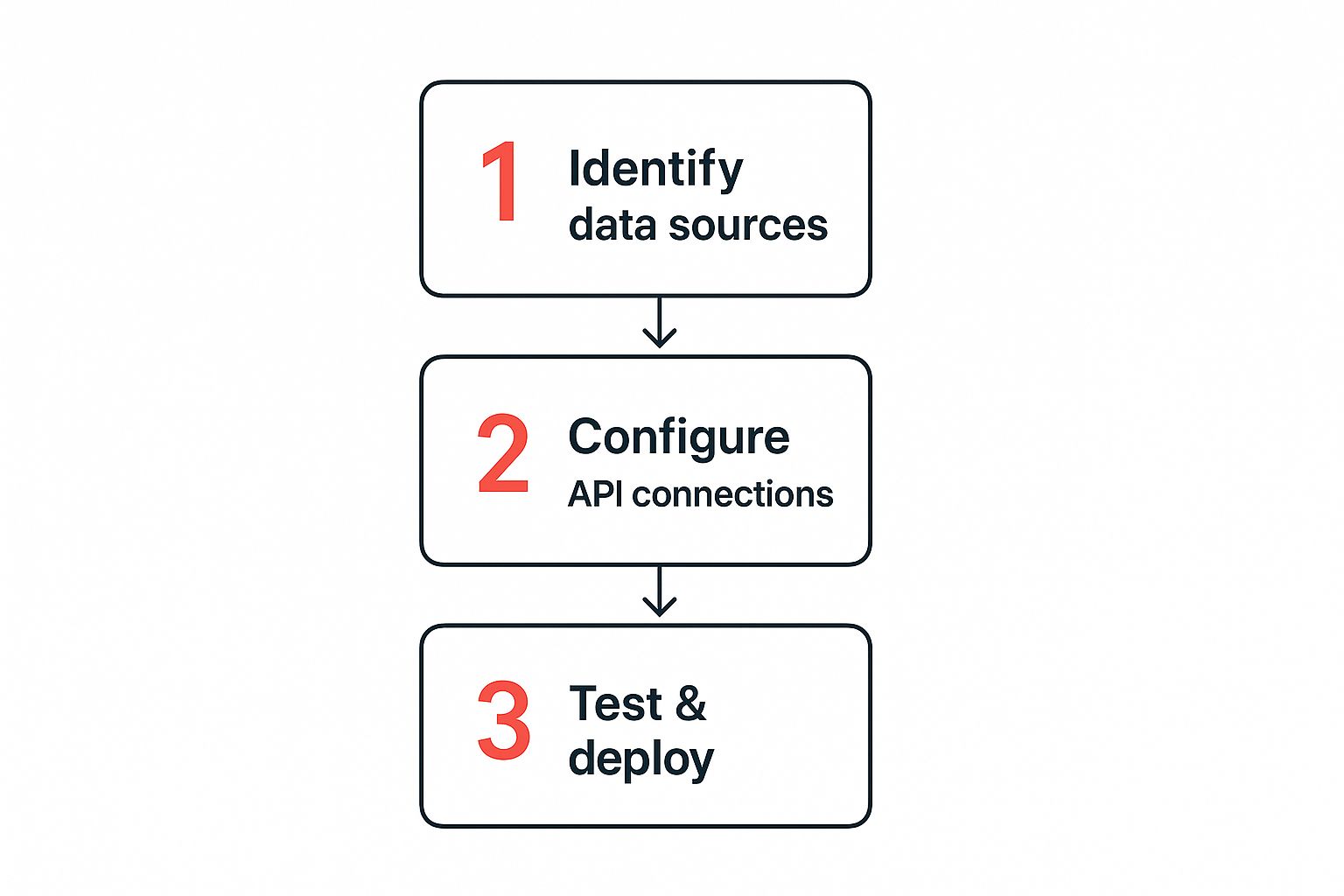So, what is CRM integration from an agency's perspective?
Think of it as the process of connecting your Customer Relationship Management (CRM) software to all the other business apps your agency uses every day. This connection creates a central nervous system for your agency's data, letting different tools share information automatically. No more manual data entry. No more copy-pasting between systems.
For your agency, this means your project management platform, your billing software, and your marketing tools can all finally speak the same language.
The High Cost of Disconnected Agency Systems
Imagine running a busy restaurant kitchen where the chefs, servers, and inventory managers can't talk to each other. Servers take orders without knowing which ingredients are out of stock. Chefs prepare dishes that were never ordered. The front-of-house has no clue when food will actually be ready.
The result is pure chaos, wasted food, and seriously unhappy customers. This is exactly what happens in an agency trying to operate with disconnected systems.
When your CRM, project management software, and billing tools are all isolated islands, you create information silos. Your account team might not know about a critical update the project manager just logged. Your sales team could be pitching a new service to a client who has a massive overdue invoice.
This operational drag is more than just an annoyance—it's a real problem for agency growth.
The Consequences of Data Silos for Agency Growth
Disconnected data isn't just inconvenient; it actively stunts your agency's growth. The fallout usually looks something like this:
- Duplicated Effort: Teams waste hours manually re-entering the same client information into multiple platforms. It's a boring, repetitive task that's just begging for human error.
- Missed Opportunities: Without a single, unified view of your clients, it’s nearly impossible to spot upsell opportunities or identify at-risk accounts before it's too late.
- Inconsistent Communication: Clients get mixed messages from different departments, which completely erodes their trust and makes your agency look disorganized.
These data silos are a massive roadblock. In fact, 81% of IT leaders report that isolated data gets in the way of their digital transformation efforts. On the flip side, companies that adopt integrated CRM platforms have seen an average 25% increase in marketing ROI, proving just how much a unified view of data can optimize performance. Want to dig deeper? You can discover more insights about the impact of data silos and CRM integration.
At the end of the day, these inefficiencies hit your bottom line and kill your ability to scale. Understanding the chaos that disconnected systems create is the first step toward embracing a better way. For a real-world look at how agencies run, check out places like FreeForm Agency.
Building your agency on a unified system is no longer a luxury—it’s essential for survival and growth. Without it, you're not building client relationships; you're just managing chaos.
Defining CRM Integration in the Agency Context

So, what is CRM integration in a way that actually matters to your agency? Forget the textbook definitions for a second. Think of it as the central nervous system for your entire operation.
It’s the digital plumbing that connects your most critical tools, creating a seamless, two-way street for information to flow. This lets your CRM, project management software, billing system, and email platform talk to each other automatically and in real time.
Essentially, integration transforms your CRM from a static digital address book into a dynamic, intelligent hub for all client activity. It becomes the single source of truth that your whole agency can rely on.
Evolving Your CRM From a Simple Database to an Intelligent Agency Hub
Without integration, your CRM is just a silo of contact info. It tells you who your clients are, but it knows next to nothing about their journey with you. You have their names and phone numbers, but the real story—project updates, invoice histories, support tickets—is scattered across a dozen different apps.
With integration, that fragmented story finally comes together. Your CRM evolves from a simple database into a command center that gives you a complete, 360-degree view of every single client relationship.
By connecting client-facing data from your CRM with operational details from other tools, you create a powerful synergy. This unified view lets your sales, project, and account teams see real-time client data, preferences, and project statuses, leading to smarter, more personalized communication.
This connection isn't just about convenience; it’s about building a more proactive, intelligent agency. You can finally track the entire client lifecycle—from initial lead capture and proposal all the way to project delivery, billing, and follow-up—all from one place.
The table below breaks down just how transformative this shift can be for the core software your agency already uses.
Core Components of Agency CRM Integration
As you can see, connecting these systems eliminates the endless back-and-forth and the risk of crucial details falling through the cracks. Instead of working in separate apps, your teams start working through a single, unified workflow powered by your CRM.
Four Key Benefits of an Integrated CRM for Your Agency

Connecting your systems is about more than just a tidy tech stack. It’s about unlocking real, tangible value that hits your agency’s bottom line and makes day-to-day life easier for your team. When your CRM is the central hub, powerful improvements ripple across the entire business.
For agencies, the payoff from CRM integration really comes down to four key pillars. Each one solves a core challenge you're probably facing right now, from workflow bottlenecks to long-term strategic blind spots.
Let's break down exactly what that looks like.
Benefit 1: Superior Operational Efficiency
Disconnected tools are the number one cause of wasted time in any agency. Think about it—all that copying, pasting, and double-checking data between platforms adds up. Integration crushes this friction by letting your most important tools talk to each other automatically.
Imagine your client onboarding process. Without integration, winning a new client sets off a frantic chain of manual tasks. Someone has to create a project in Asana, set up a folder in Google Drive, add them to your billing software, and then ping the project manager on Slack. It’s a recipe for human error.
With an integrated CRM, this whole sequence just… happens. The second a deal is marked "won," the system can instantly:
- Populate a new project in your project management tool, pulling in all the client notes.
- Generate and send the first invoice from your accounting software.
- Notify the assigned account manager with all the deal info they need to get started.
This hands-off approach frees your team from soul-crushing admin work. They can finally focus on the high-value activities that actually serve clients and grow the business.
Benefit 2: Deeper, More Strategic Client Relationships
Real partnership isn't built on transactions; it's built on understanding and trust. An integrated CRM gives your team a complete, 360-degree view of every client interaction, empowering them to deliver service that feels personal and proactive.
When your account managers can see a client’s entire project history, recent support tickets, and latest payments all in one place, every conversation starts with full context. They can tailor their outreach based on what's actually happening, not guesswork. No more pitching a new service to a client who just had a support issue resolved.
A unified client view transforms your team from reactive problem-solvers into strategic partners. They can anticipate needs, spot potential issues before they escalate, and offer solutions that align with the client’s bigger goals.
This level of insight is the bedrock of lasting partnerships. If you're looking to forge stronger connections, explore proven client relationship management tips—an integrated CRM is the machine that helps you execute those strategies flawlessly.
Benefit 3: Smarter, Data-Driven Agency Decisions
Agencies run on data, but when it’s scattered across a dozen different platforms, seeing the big picture is nearly impossible. CRM integration pulls all your information into one place, turning fragmented data points into clear, actionable insights for smarter planning.
By combining sales data from your CRM with financial data from billing and project data from your management tools, you can finally answer the big questions. Which types of projects are actually the most profitable? Which clients have the highest lifetime value? Where are the bottlenecks in our sales pipeline?
This unified reporting gives leadership the confidence to make data-backed decisions about where to invest resources, how to price services, and which leads to prioritize.
Benefit 4: A Direct Path to Greater Agency Profitability
At the end of the day, the first three benefits—efficiency, stronger relationships, and smarter decisions—all funnel into one critical outcome: increased profitability.
By automating workflows, you reduce overhead and free up more billable hours. By deepening client relationships, you boost retention and uncover upsell opportunities, directly driving revenue.
And by making data-driven decisions, you ensure your agency’s time and energy are always focused on what moves the needle. An integrated CRM isn’t just a tech upgrade; it’s a direct investment in your agency’s financial health.
Mapping a Real-World Agency Integration Workflow
Theory is great, but let's get real. To really wrap your head around what CRM integration is, you need to see it working in the wild. Let’s follow the journey of a new client at a modern agency, from their first click on your website all the way to their final invoice.
This story isn't about the tech itself. It’s about the ridiculously smooth, automated experience that a connected system creates for both your team and your clients.
Step 1: From Lead Capture to Project Kickoff
It all starts the moment a potential client—let's call her Jane—fills out the "Request a Quote" form on your website.
- Lead to CRM: That form is hooked directly into your CRM. The second Jane hits "submit," her info (name, company, email, project needs) instantly creates a new lead record. No one on your team has to lift a finger for data entry.
- Automated Follow-Up: This kicks off an automation. Your email tool, say Mailchimp, immediately sends Jane a personalized "Thanks for reaching out!" email, confirming you got her request and letting her know what to expect next.
- Sales Notification: At the exact same time, the CRM assigns Jane's lead to a sales rep and drops a task in their queue to call her within 24 hours. Boom—a guaranteed prompt response.
This whole sequence is frictionless. Your agency looks sharp and on the ball, and your sales team gets everything they need to have a meaningful conversation from the get-go.
It's no surprise the global CRM software market is exploding. It was valued at a massive $101.4 billion in 2024 and is projected to hit $262.74 billion by 2032. This incredible growth shows just how essential these systems have become for managing client relationships and keeping businesses running smoothly.
So how do these connections actually get built? This infographic breaks down the basic flow for setting up a new integration.

As you can see, it’s all about figuring out which systems need to talk, setting up the connection (usually with something called an API), and then testing to make sure the data is flowing just right.
Step 2: From Won Deal to Seamless Invoicing
Fast forward a bit—after a great discovery call and a killer proposal, your sales rep marks the deal as "Won" in the CRM. That one click unleashes another wave of automation.
- Project Creation: Your CRM talks to your project management software, like Asana, and automatically spins up a new project board. It pulls in all the client details, notes from the sales calls, and the initial scope of work. We dive deeper into this in our guide on project management for agencies.
- Billing Activated: It then pings your accounting software, like QuickBooks, telling it to generate the first invoice and set up a new client profile for all future billing.
- Team Handoff: The assigned project manager gets an automated notification with a link to the new project board. They have instant access to all the context they need to kick things off without a single "Hey, can you forward me those notes?" email.
When you map it all out like this, you can see how an integrated CRM gets rid of clumsy manual handoffs, stops important details from falling through the cracks, and makes the transition from sales to delivery completely seamless.
Supercharging Your CRM with AI Integration for Agencies
Standard CRM integration is a game-changer, no doubt. It connects all your tools into one cohesive workflow, which is a massive leap from juggling a handful of disconnected systems. But the real magic happens when you add an intelligent layer on top of all that connected data: Artificial Intelligence.
Think of it this way: a basic CRM integration is like having a perfectly detailed roadmap. It shows you every street and landmark. AI integration, on the other hand, is like upgrading to a live GPS that not only shows you the map but also predicts traffic jams, suggests faster routes, and helps you navigate around problems before you even hit them.
Turning Your Agency's Historical Data into a Predictive Powerhouse
AI doesn't come in and replace your integrated CRM; it makes it smarter. It sifts through the mountains of client emails, project notes, and sales history flowing through your systems, spotting patterns and trends that are completely invisible to the human eye. Suddenly, your agency has predictive capabilities that feel like a superpower.
This convergence of AI and CRM is creating some serious waves. The AI-powered CRM market is on track to hit a staggering $80 billion globally by 2025, and for good reason. It’s been shown to boost sales team productivity by up to 40% and increase pipeline conversion rates by an estimated 56%. If you're curious, you can discover more CRM statistics and their impact on sales to get the full scoop.
This intelligent layer helps your team shift from being reactive to proactive. You start anticipating client needs instead of just responding to them.
Practical AI-CRM Applications for Your Agency
So, what does this actually look like day-to-day for an agency? We're not talking about futuristic robots taking over. It’s about practical, everyday tools that solve real problems and open up new doors for growth.
Here are a few ways AI integration can level up your agency's CRM:
- AI-Driven Lead Scoring: Instead of treating every new lead the same, AI dives deep. It analyzes a prospect’s company info, their engagement with your content, and even the language they use in emails to assign a predictive score. This lets your sales team pour their energy into the leads who are actually ready to become high-value clients.
- Predictive Churn Analytics: AI can act as an early warning system. By monitoring client communication, project progress, and billing history, it can flag accounts that are showing signs of drifting away. This gives your account managers a heads-up to step in and save the relationship before it's too late.
- Automated Sentiment Analysis: AI tools can read the room for you. They automatically analyze the tone of emails, meeting transcripts, and support tickets to gauge how a client is feeling. It's like having a real-time pulse check on client health, helping you proactively manage relationships and put out fires before they start.
By adding this layer of intelligence, you can build a smarter, more resilient agency. If you want to dive deeper into this topic, check out our guide on how AI is helping agencies today.
Answering Your Agency's Top CRM Integration Questions

Even after seeing all the benefits laid out, I get it—diving into CRM integration can feel like a huge leap. Agency leaders tend to run into the same questions and hurdles when they start thinking about connecting all their different tech tools.
Let’s tackle those head-on. This section is all about giving you direct answers to the questions we hear most often, so you can move forward feeling confident instead of confused.
Which CRM is best for integrating with our agency's tools?
This is easily the most common question, and the honest answer is: there's no single "best" CRM for every agency out there. The right choice is all about your specific tech stack, your team’s size, and your budget.
Platforms like HubSpot, Salesforce, and Zoho CRM are popular for a reason—they come with massive integration marketplaces and flexible APIs that play nicely with other software.
Here’s where to start: audit the tools you already use every day. List out your project management software (like Asana or Monday.com), your communication channels (hello, Slack), and your finance tools (QuickBooks, anyone?).
Once you have that list, you can evaluate CRMs based on how many of those tools they offer pre-built, seamless connectors for. A robust API is your safety net, ensuring you can build custom connections down the road if a direct one doesn't exist.
How much technical skill do we need for CRM integration?
This is a big one, and the reality is a lot less scary than you might think. For most agencies, the answer is surprisingly little.
Many modern CRMs now offer native, "no-code" integrations for the most popular apps. This means you can connect tools like Google Workspace or Mailchimp with just a few clicks inside a user-friendly menu. No programming required.
For workflows that are a bit more complex or involve multiple steps, you’ll probably look at a third-party integration platform.
- No-Code/Low-Code Platforms: Tools like Zapier or Make act as a bridge between your apps. They let you build automated workflows (we call them "zaps" or "scenarios") like, "When a deal is marked 'Won' in our CRM, automatically create a new project in Asana."
- Custom Development: For really specialized needs or connecting with ancient, legacy software, you might need to bring in a developer or an implementation partner.
Honestly, though? Most agencies can achieve some seriously powerful automation using only the no-code solutions available today.
What are the biggest integration mistakes our agency should avoid?
Knowing what not to do is just as important as knowing what to do. A few common missteps can completely derail an integration project that started with the best intentions.
The single biggest mistake is failing to define clear goals from the get-go. Don't just connect tools for the sake of it. Before you touch a single setting, map out the specific agency pain points you want to solve. Are you trying to automate client onboarding? Speed up proposal generation? Smooth out the handoff from sales to the project management team?
A clear objective acts as your North Star, guiding every decision you make during the implementation process. Without it, you risk creating a complex web of connections that adds more confusion than clarity.
Another huge pitfall is bad data hygiene. If you integrate systems filled with inconsistent, outdated, or duplicate data, you're just going to spread that mess everywhere. It’s like hooking up clean pipes to a dirty water source. Before you connect anything, dedicate time to cleaning and standardizing your client data inside your CRM first. This foundational step ensures the information flowing between your tools is actually reliable.
Finally, don’t neglect user training and adoption. An integrated system is only valuable if your team actually uses it. You have to show them how the new, connected workflow operates, explain how it makes their day-to-day tasks easier, and give them the support they need to make the switch.
Ready to automate your post-meeting workflows and connect your client conversations directly to your CRM? Scribbl integrates seamlessly with HubSpot, Salesforce, and more, automatically creating summaries, action items, and follow-up tasks from every call. Discover how you can save time and close deals faster at https://www.scribbl.co.




